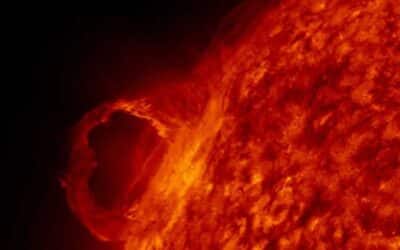The New York Times reports that, according to a new study, human CO2 emissions “are causing the ocean to rise at the fastest rate since at least the founding of ancient Rome”.
It scarily adds, “The findings are yet another indication that the stable climate in which human civilization has flourished for thousands of years, with a largely predictable ocean permitting the growth of great coastal cities, is coming to an end.”
Oh my!
Citing a recent study to support it’s sensationalist reporting, the Times states, “Due largely to human emissions, global temperatures have jumped about 1.8 degrees Fahrenheit since the 19th century. The sea is rising at what appears to be an accelerating pace, lately reaching a rate of about a foot per century.”
Here’s the study’s graph of what that looks like:

Well, that certainly looks pretty frightening!
But is the rising sea level really a threat to human civilization as we know it? Is it really accelerating at an alarming rate? And how certain can we be that this is the result of human activities rather than natural climate variability?
The Times offers some clues, starting with the acknowledgment that sea level rose at a comparable rate, though for shorter duration, during Roman times. Needless to say, that wasn’t caused by human activity.
Further down the page, the Times notes that, going even further back into the record, “sea level rose drastically at the end of the last ice age, by almost 400 feet, causing shorelines to retreat up to a hundred miles in places.” It’s been more stable since, during the present Holocene epoch, about the past 12,000 years.
While the rate of rise is about a foot per century today, at the end of the last ice age, the rate of sea level was about 1 meter per century, interrupted by even more rapid increases where the rate of rise reached about 2.5 meters per century.
So the rate of increase is not unprecedented and well within the bounds of natural variability. Of course, it makes perfect sense that the oceans would have risen faster then, with the Earth coming out of an ice age and all. It isn’t doing so today. This brings us back to the concern about human CO2 emissions contributing to rising temperatures and hence to the rise in sea level. So are today’s high temperatures unprecedented for interglacial periods?
No. Vostok ice core data from Antarctica shows that the last four interglacial periods were at least as warm or warmer than the present Holocene, despite considerably lower atmospheric CO2 concentrations than exist now (over 400 ppm as of January). In the following graph, the top line (a) is atmospheric CO2 and the second line down (b) is temperature (the left side is present day and the further to the right, the further back in time).

One thing to note about the Holocene is that it is an unusually long warm period. In fact, we’re well overdue for another ice age. As the authors of this study note, “As judged from the Vostok record, the long, stable Holocene is a unique feature of climate during the past 420 kyr, with possibly profound implications for evolution and the development of civilizations.”
Hence, the Times could just as well have argued that “the stable climate in which human civilization has flourished for thousands of years” thankfully does not seem to be coming to and end just yet.
Another thing to point out about this is that, while strongly correlated, the changes in CO2 lag the changes in temperature by at least several hundred years, meaning that CO2, while no doubt a feedback magnifier, isn’t the driving force behind the temperature changes (notwithstanding Al Gore’s deceitful implication to the contrary in his ironically-titled film An Inconvenient Truth).
As the authors of the Vostok data study note, “much of the variability occurs with periodicities corresponding to that of the precession, obliquity and eccentricity of the Earth’s orbit.” That is, it’s driven by the sun and Earth’s relative position to it. They note that “climate has almost always been in a state of change during the past 420 kyr but within stable bounds (that is, there are maximum and minimum values of climate properties between which climate oscillates).”
Present day temperatures fall within the stable bounds of this natural variability, apart from the fact that, again, the Holocene warm period has been unusually long.
So how did the authors of the paper determine that recent warming has been due largely to human emissions?
Answer: They didn’t. They just assumed it.
What they did was to take the sea level increase from 500 – 1800 CE, compare it to the more recent increase, and attribute the rate difference to human emissions. In other words, they employed the logic: Since the recent sea level rise is greater than the rise seen from 500 – 1800 CE, therefore it must be due to human activities.
Now, we know that CO2 emissions are contributing to temperature increases and thus the rise in sea level. But the above syllogism is a non sequitur. It’s not science. It’s unscientific. It’s a double fallacy, as they use employ this non sequitur in order to essentially adopt as their premise the proposition to be proven, which is the additional fallacy of petitio principii, or begging the question. The truth is we just don’t know how significant this human contribution to atmospheric CO2 is with regard to warming temperatures. We can’t quantify the extent to which, all else remaining the same, CO2 is contributing to warming.
To illustrate, let’s return to the Times article. Tellingly, it notes, “In the 19th century, as the Industrial Revolution took hold, the ocean began to rise briskly, climbing about eight inches since 1880.”
But can this increase in temperatures since 1880 be attributed entirely, or even mostly, to human CO2 emissions, as the Times implies? Conveniently, they link to the study they got this information from, so let’s see what that rise in sea level since 1860 actually looks like:
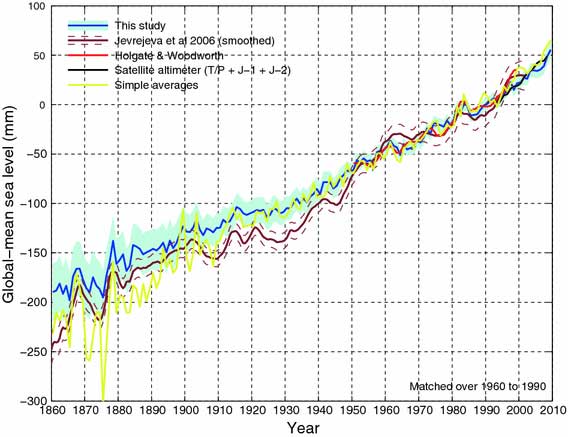
As you can see, the sea level has been rising at a fairly steady rate since at least 1860. Did human CO2 emissions in the late 1800s really cause this trend to start?
Answer: No, they didn’t. The human contribution to atmospheric CO2 didn’t really start becoming significant until the turn of the century, and didn’t really take off until about 1940.

And what did temperatures look like over this time? Here’s the data from the UK’s Met Office Hadley Centre (HadCRUT 4 temperature data), extending as far back as the record goes:
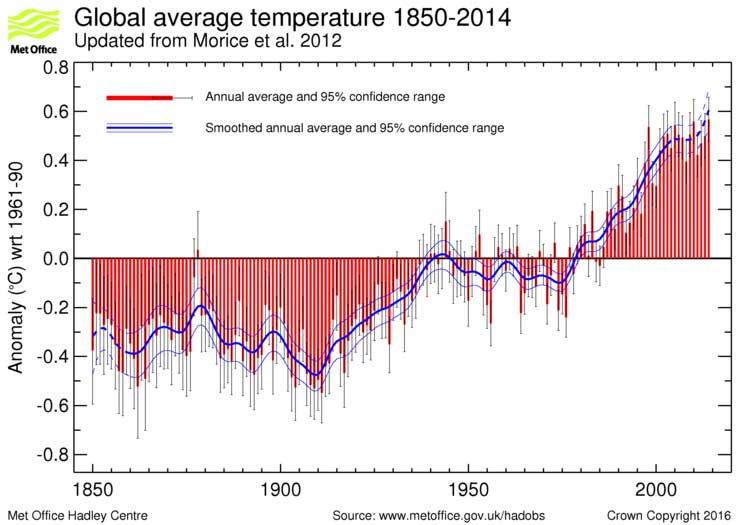
Note that while the overall trend from 1850 to the present has been warming global temperatures, there were actually periods of net cooling from 1850 to about 1910 and from about 1945 to 1975.
Here’s a closer look at HadCRUT4 temperatures for that period of 1850 to 1910:
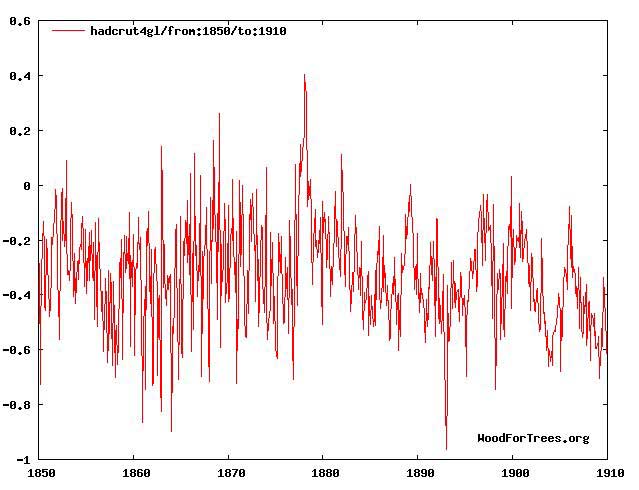
So was the Industrial Revolution driving the rise in sea level during this time, as the New York Times would have its readers believe?
No.
Sea level also continued its steady increase during the post-WWII cooling, which, notably, occurred right when human emissions of CO2 were really starting to take off.
So have global temperatures been increasing at an accelerated pace in accordance with the acceleration of sea level rise reported by the Times?
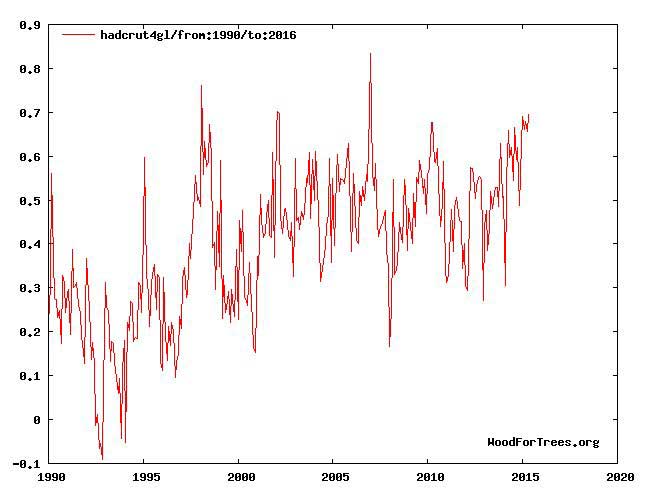
Nope. Have a closer look at the raw HadCRUT4 data since 1990:Temperatures have actually plateaued over the past 18 years or so. Here’s what this “hiatus” or “pause” (as it is referred to in the scientific literature) in global warming looks like from the satellite data (both RSS, red, and UAH, green):

In fact, if we add a trendline to the RSS satellite data since 1998, there has actually been slight cooling:

If we exclude the higher temperatures from the strong El Niño in the late nineties by starting the trend from 2000, there’s been only very slight warming, at least in part due to the current strong El Niño:

So, far from accelerating, global temperatures have actually plateaued. So what about sea level? Citing the aforementioned study, the Times tells us that the rate of sea level rise is accelerating. How certain are we of this?
Well, one can find contradictory information in the scientific literature. According to a study published in October 2013 in the journal Nature Climate Change, “Since the early 1990s, sea level rose at a mean rate of ~3.1 mm yr−1. However, over the last decade a slowdown of this rate, of about 30%, has been recorded. It coincides with a plateau in Earth’s mean surface temperature evolution, known as the recent pause in warming.” (Emphasis added.)
They cite numerous other studies for this, including one by leading climate alarmist James Hansen of NASA. Here’s what that study shows for the increase in sea level since the early nineties:

Now, keep in mind that both this “hiatus” in global warming and this slowdown in the rate of sea level rise have occurred despite continuously rising atmospheric CO2:
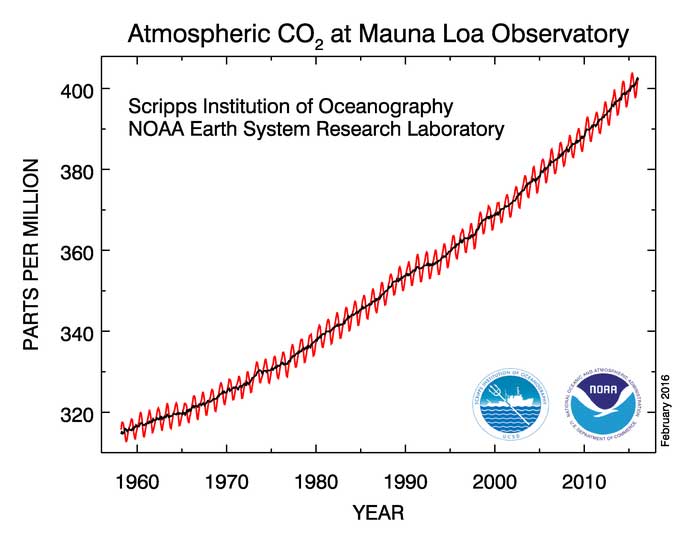
Obviously, there is a considerable amount of natural variability and countless other factors affecting Earth’s climate besides the level of atmospheric CO2.
In fact, let’s take a closer look at the rising sea level of more recent history again. What would it look like going back to 1700? Well, a 2008 study published in Geophysical Research Letters shows us:

As you can see, rising sea levels didn’t begin with the Industrial Revolution, as the Times misleadingly suggests. Obviously, something besides human contributions to CO2 were driving this trend that began 200 years ago.
The Times ends on a dramatic note. They point out that one of the authors of the study they cite, Dr. Stefan Rahmstorf, “had previously published estimates suggesting the sea could rise as much as five or six feet by 2100. But with the improved calculations from the new paper, his latest upper estimate is three to four feet.”
But Dr. Rahmstorf hasn’t given up on his prediction, just delayed it. The Times adds, “In an interview, Dr. Rahmstorf said the rise would eventually reach five feet and far more — the only question was how long it would take.”
How can Dr. Rahmstorf be so certain? The answer is that he can’t possibly be. This is faith, not science. It’s dogma.
Now, again, I’m not saying human activities aren’t contributing to rising temperatures. I’m just suggesting we take a step back, approach the matter with appropriate skepticism as any good scientist must do, and humbly accept and acknowledge the limits of our knowledge about the complexities involved in Earth’s climate.
I’m also not saying that burning fossil fuels is a good thing. It would be great to have clean energy, and coal plants emit many pollutants — CO2 just isn’t one of them. Mercury and lead are certainly things we don’t want emitted into the air we breathe, but life evolved on this planet with much higher levels of CO2 than exist today, and more of it does have its benefits. More CO2 means that plant life on Earth will thrive. Agricultural crops will have greater biomass, produce more yield, and make more efficient use of water, all of which will help to feed the growing human population. That’s important.
Furthermore, government bureaucrats making decisions at best arbitrarily don’t know better than the free market with its pricing system how to efficiently direct scarce resources towards productive ends as determined by the will of the consumers. If people choose voluntarily to pay more for cleaner energy, that’s wonderful. But imposing higher energy prices through legislation disproportionately harms the poor, who have to spend a much higher proportion of their limited income on energy.
So what’s the takeaway here? It’s this: The sky is not falling, you probably don’t need to start building an Ark to save yourself from the flood just yet, and the Earth’s pleasant warm climate today is far preferable to the ice age we’re long overdue for. So relax and enjoy it, and if you want to make a difference, then do so of your own free will rather than advocating the government use of force to impose behavioral changes on others at great expense to the poorest among us.
